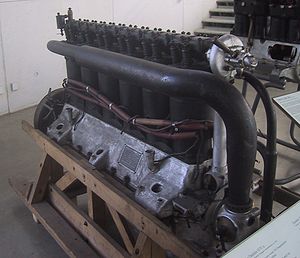- Mercedes D.IVa
-
D.IVa Mercedes D.IVa at the Deutsches Museum. The prominent black piping is the inlet manifold from the carburetor Type Inline piston engine Manufacturer Daimler Motoren Gesellschaft (DMG) First run 1917 The Mercedes D.IVa was a six-cylinder, water-cooled, inline engine developed in Germany for use in aircraft and built by Daimler Motoren Gesellschaft (DMG).[1]
Contents
Design and development
The D.IVa replaced the failed Mercedes D.IV inline eight-cylinder engine. The D.IVa was primarily used to power bombers and large reconnaissance aircraft. Unlike most German designs, the D.IVa was relatively advanced, including four valves per cylinder powered by an overhead cam, also used on the earlier two-valve per cylinder D.I through D.IIIa powerplants. Designed specifically to be installed in the fuselage, the engine featured a number of design elements intended to reduce its width. For instance, the carburetor was placed behind the engine, feeding fuel to the cylinders via a long pipe. This had the disadvantage of poor fuel distribution. Two versions of the engine were produced in mirror copies, running in opposite directions.
Applications
- Gotha G.III
- Gotha G.IV
- Gotha G.V
- Gotha G.VI
- Gotha G.VII
- Linke-Hofmann R.I
- Linke-Hofmann R.II
- Rumpler C.IV
- Zeppelin Staaken R.VI
Specifications (D.IVa)
General characteristics
- Type: 6-cylinder, inline piston engine
- Bore: 160 mm (6.3 in)
- Stroke: 180 mm (7.09 in)
- Displacement: 21.72 L (1,324.92 cu in)
- Dry weight: 1,099 lb
Components
- Fuel system: Twin jet Mercedes carburettor with automatic mixture control
- Oil system: Forced feed to bearings and camshaft
- Reduction gear: Direct drive, left-hand tractor
Performance
- Power output: 252 hp at 1,400 rpm
- Compression ratio: 4.94:1
- Fuel consumption: 125 pints per hour
- Oil consumption: 8.125 pints per hour
See also
- Related lists
References
Notes
Bibliography
- Gunston, Bill. World Encyclopedia of Aero Engines. Cambridge, England. Patrick Stephens Limited, 1989. ISBN 1-85260-163-9
- Jane's Fighting Aircraft of World War I. London. Studio Editions Ltd, 1993. ISBN 1-85170-347-0
External links
Mercedes aircraft engines Piston engines Lists relating to aviation General Aircraft (manufacturers) · Aircraft engines (manufacturers) · Airlines (defunct) · Airports · Civil authorities · Museums · Registration prefixes · Rotorcraft (manufacturers) · TimelineMilitary Accidents/incidents Records Categories:- Mercedes aircraft engines
- Aircraft piston engines 1910-1919
Wikimedia Foundation. 2010.

